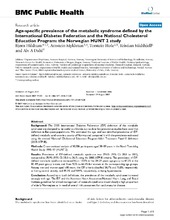Age-specific prevalence of the metabolic syndrome defined by the International Diabetes Federation and the National Cholesterol Education Program: the Norwegian HUNT 2 study
Peer reviewed, Journal article
Permanent lenke
https://hdl.handle.net/1956/2644Utgivelsesdato
2007-08-29Metadata
Vis full innførselSamlinger
Originalversjon
https://doi.org/10.1186/1471-2458-7-220Sammendrag
Background: The 2005 International Diabetes Federation (IDF) definition of the metabolic syndrome was designed to be useful worldwide, but to date few prevalence studies have used that definition in European populations. We estimated the age- and sex-stratified prevalence of IDFdefined metabolic syndrome in a county of Norway and compared it with the prevalence estimated using the revised National Cholesterol Education Program-Adult Treatment Panel-III definition (2005 ATP III). Methods: Cross-sectional analysis of 10,206 participants aged 20–89 years in the Nord-Trøndelag Health Study 1995–97 (HUNT 2). Results: Prevalence of IDF-defined metabolic syndrome was 29.6% (95% CI: 28.8 to 30.5), compared to 25.9% (95% CI: 25.0 to 26.7) using the 2005 ATP III criteria. The prevalence of IDFdefined metabolic syndrome increased from 11.0% in the 20–29 years age group to 47.2% in the 80–89 years group in men, and from 9.2% to 64.4% for women in the corresponding age groups. Among men and women aged ≥60 years, the IDF criteria classified 56.7% and 75.0%, respectively, as having central obesity, and 89.3% and 90.9%, respectively, as being hypertensive. Conclusion: According to both definitions, the prevalence of the metabolic syndrome increased strongly with age. The IDF and the American Heart Association/National Heart, Lung, and Blood Institute guidelines for clinical management of metabolic syndrome would classify a high proportion of elderly Norwegians as in need of overall risk assessment for cardiovascular disease.
